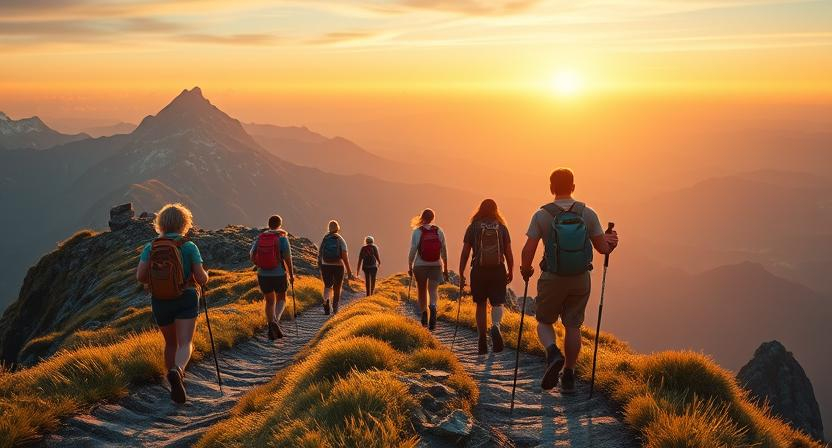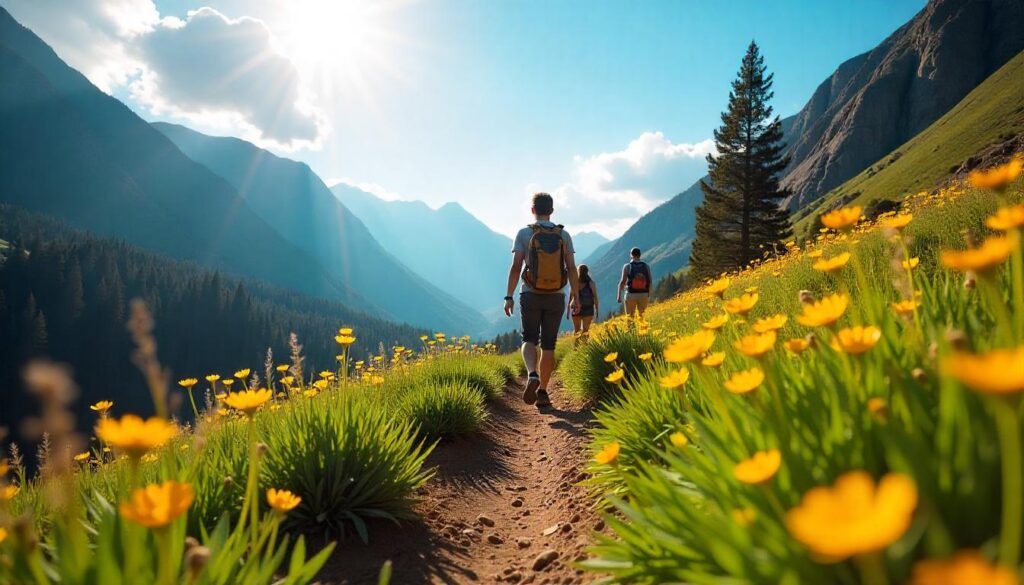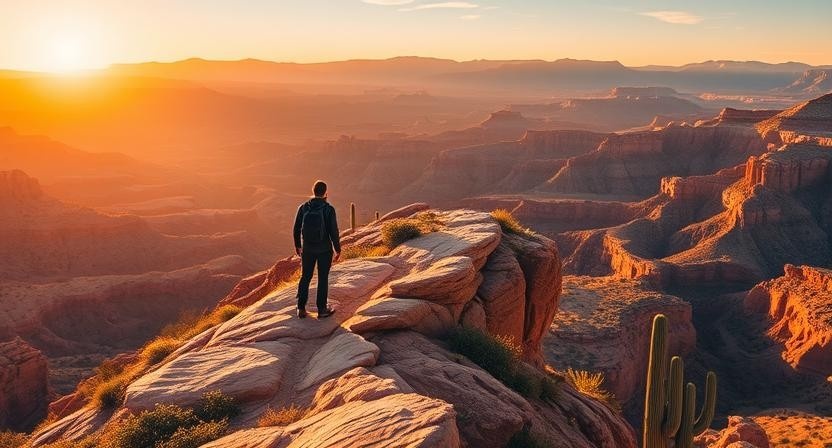
Welcome to Hiking in Arizona
Arizona is a unique hiking destination known for its diverse landscapes—from its arid deserts and rugged mountains to lush canyons and iconic red rock formations. Hiking in Arizona offers a wide array of experiences that cater to beginners, families, and experienced adventurers alike. In this guide, we will cover everything from best hikes in Arizona to other hidden gems of Arizona and seasonal tips that will help you make the most of your outdoor adventures. Whether you’re planning a quick day hike or an extended backpacking trip, this comprehensive guide is designed to inspire and equip you with expert tips and practical advice.
Arizona’s natural beauty is not only breathtaking but also incredibly varied. From the sun-scorched deserts near Phoenix to the cooler, forested areas in the north, the state offers trails that showcase each unique ecosystem. As you explore our guide, you will discover why Arizona is a top destination for outdoor enthusiasts and how local culture and organized Arizona hiking tours further enrich the hiking experience. Learn more about local hiking events and community trails by visiting resources like the Arizona State Parks website for up-to-date information on trail conditions and park regulations.
Why Hiking in Arizona Is a Must
Diverse Landscapes and Scenic Trails
Arizona boasts an array of striking natural features that create a stunning backdrop for any hike. The state is home to dramatic red rock canyons that contrast beautifully with expansive desert vistas and cool, forested areas that provide a refreshing escape from the heat. Imagine wandering along a trail that reveals the most scenic places in Arizona—with each turn offering a new, breathtaking view. Whether you are trekking along the iconic red rock formations of Sedona or exploring lesser-known trails through remote desert landscapes, Arizona’s beauty is captured in every beautiful hiking trail in Arizona.
The unique terrain means that each hike feels like a new adventure. The interplay of light and shadow on the rugged landscape adds a dynamic element to the scenery, making every hike a visual treat. By traversing diverse environments, you’ll experience the full range of what Arizona has to offer—from the quiet, mystic canyons to vibrant, sun-drenched plateaus.
Year-Round Outdoor Adventures
One of the best aspects of hiking in Arizona is the ability to enjoy outdoor adventures throughout the year. Arizona’s climate supports a variety of hiking conditions, making it a destination where you can truly explore all seasons. In the gentle warmth of spring, wildflowers bloom along the trails, while early-morning hikes in the summer help you avoid the harsh midday sun. Even in winter, when the air is crisp and cool, the trails remain accessible with fewer crowds and clear views.
For instance, the best hiking trails in Arizona are designed to offer favorable conditions regardless of the season. Whether you are looking for a brisk spring walk, a sunlit summer ascent, or a peaceful winter hike, there’s always an opportunity to plan your outdoor adventure according to the weather and your personal comfort.
Rich Outdoor Culture and Local Tours
Arizona’s hiking scene is supported by a vibrant community of outdoor enthusiasts and local experts who share their passion for nature. Organized Arizona hiking tours and local trail guides are instrumental in helping newcomers navigate the best places to hike in Arizona. These tours not only provide expert insights into the terrain and safety tips but also foster a sense of community among hikers.
Local hiking groups and clubs organize regular events, trail clean-ups, and group hikes that help build a supportive network for both experienced and beginner hikers. This strong outdoor culture ensures that you will always have reliable advice and friendly company on your journeys. By participating in organized tours and engaging with community platforms like the Arizona Hikers Association, you gain firsthand knowledge of the state’s best trails and hidden gems.
Top 10 Best Hikes in Arizona You Shouldn’t Miss
1. Piestewa Peak – Phoenix, Arizona
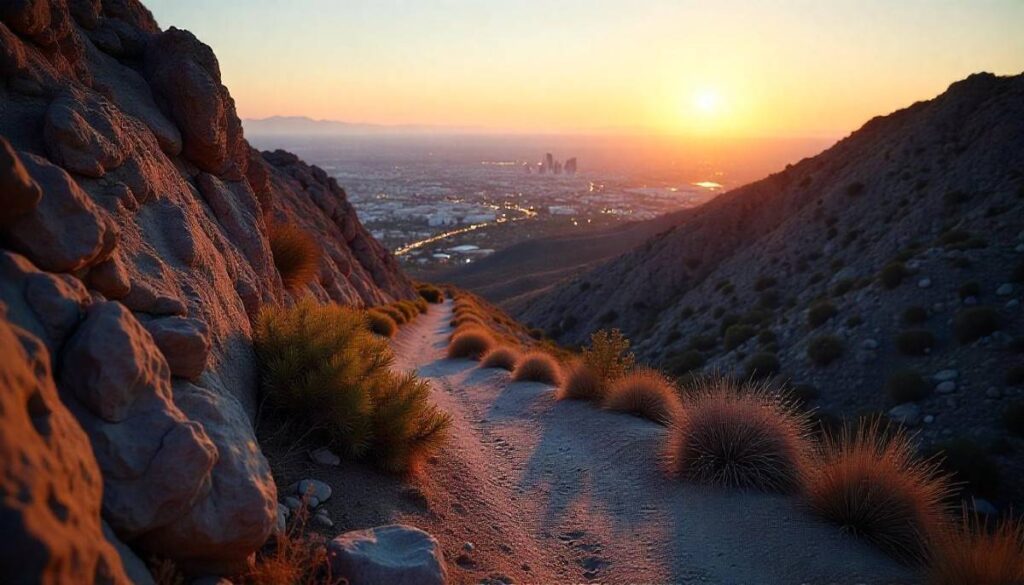
Introductory Paragraph
Piestewa Peak is an iconic urban hike in Phoenix renowned for its challenging ascent and panoramic views of the surrounding cityscape and desert. It stands out as one of the best hikes in Arizona for those looking to blend nature with urban energy. The trail offers an excellent introduction to hiking in Arizona through its varied terrain that showcases both rugged desert landscapes and a dynamic city backdrop.
Trail Distance, Difficulty & Permits
The trail is approximately 2.5 miles round-trip, with steep and rocky sections that test your balance and endurance. No permits are required to hike Piestewa Peak, though parking restrictions often apply during peak periods. This clear, accessible information is crucial for anyone planning a day hike and ensures you get the most out of your best hiking in Arizona experience.
Best Time to Visit
For optimal conditions, it is best to hike Piestewa Peak early in the morning during the spring and fall. Cooler temperatures and minimal crowds allow you to enjoy clear vistas and the best lighting conditions, making it one of the standout hiking trails in Arizona.
Personal Tips & Safety Precautions
Before heading out, be sure to carry plenty of water and consider using trekking poles on the steeper, rocky segments. It’s also wise to check local weather updates so you can plan accordingly. These practical hiking tips ensure a safe and enjoyable experience on one of the most beloved hiking spots in Arizona.
2. Shaw Butte Trail – Scottsdale, Arizona

Introductory Paragraph
Shaw Butte Trail in Scottsdale offers a moderately challenging hike marked by striking desert views and unique rock formations. Favored by local residents, this route provides an authentic taste of hiking in Arizona that captures the state’s raw beauty. Its blend of challenging climbs and scenic overlooks makes it a must-visit for anyone exploring Arizona hiking trails.
Trail Distance, Difficulty & Permits
Shaw Butte Trail spans roughly 4 miles round-trip with moderate climbs that test your endurance without overwhelming beginners. Although permits are generally not required, it’s always a good idea to check for any seasonal restrictions that may be in place.
Best Time to Visit
The best time to experience Shaw Butte Trail is during the spring and fall when temperatures are moderate. During these seasons, desert blooms add a splash of color to the landscape, enhancing your overall hiking experience and making it one of the best hiking trails in Arizona.
Personal Tips & Safety Precautions
Hikers should bring sun protection along with extra water and wear sturdy footwear, as the terrain is uneven and rocky. These simple precautions will help you safely navigate the trail, ensuring that your adventure on one of the top hiking trails in Arizona remains enjoyable and memorable.
3. Cathedral Rock Trail – Sedona, Arizona

Introductory Paragraph
Cathedral Rock Trail is one of the most famous hikes in Sedona, celebrated for its dramatic red rock spires and breathtaking views. This trail attracts photographers and spiritual seekers alike, showcasing the magical allure of hiking in Arizona. Its steep ascent and awe-inspiring vistas have made it a benchmark for beautiful hiking trails in Arizona.
Trail Distance, Difficulty & Permits
The trail is a 1.2-mile steep ascent that requires careful footing. While no permits are necessary, it can become quite busy, so planning ahead is essential to avoid the crowds and ensure a pleasant experience.
Best Time to Visit
For the best light and temperature, it is recommended to hike Cathedral Rock early in the morning or late in the afternoon. These times help capture the vivid colors of the rocks while avoiding the intense midday heat typical of the desert.
Personal Tips & Safety Precautions
Bring a camera to capture the spectacular views, as well as trekking poles to help with the uneven terrain. Ensure you carry plenty of water and practice caution on the steep sections, making this one of the most scenic hikes in Arizona that is as rewarding as it is challenging.
4. Devil’s Bridge Trail – Sedona, Arizona

Introductory Paragraph
Devil’s Bridge Trail is a must-visit for anyone exploring hiking in Sedona, Arizona. Famous for its natural sandstone arch, this trail offers awe-inspiring views of the surrounding red rock landscape that are both dramatic and serene. It epitomizes the unique blend of adventure and natural beauty found on the best hikes in Arizona.
Trail Distance, Difficulty & Permits
The trail is approximately 4 miles round-trip and is considered moderately challenging. While no permits are required for this hike, parking can be limited during weekends, so early arrival is recommended.
Best Time to Visit
It is ideal to visit Devil’s Bridge during the cooler months of spring and fall when the weather supports extended hiking sessions and the natural light is perfect for photography.
Personal Tips & Safety Precautions
Arrive early to avoid the crowds, check trail conditions online ahead of time, and prepare for a mix of sandy and rocky terrain. These tips, along with personal experience from local hikers, make this one of the best hikes in Arizona for those seeking natural landmarks and adventure.
5. South Kaibab Trail – Grand Canyon, Arizona

Introductory Paragraph
The South Kaibab Trail is a world-renowned route that offers some of the most spectacular views of the Grand Canyon, making it a top choice among experienced adventurers. This iconic trail is recognized as one of the best hikes in Arizona for its breathtaking scale and the unique challenge it presents to seasoned hikers.
Trail Distance, Difficulty & Permits
The distance of the South Kaibab Trail varies depending on the chosen route. Known for its strenuous nature, it requires careful planning and physical readiness. A permit is required for overnight trips, so be sure to secure one well in advance if you plan to extend your adventure.
Best Time to Visit
Shoulder seasons, such as early spring or late fall, are the best times to hike this trail. During these periods, the canyon’s vibrant colors are at their peak, and the temperatures are more moderate, ensuring a safer and more enjoyable experience.
Personal Tips & Safety Precautions
Always carry plenty of water, start your hike early to avoid the heat, and take regular breaks to recharge. For the latest trail conditions, check updates on the Grand Canyon National Park website. These expert insights make navigating one of the most challenging hiking trails in Arizona an achievable goal.
6. Humphreys Peak Trail – Flagstaff, Arizona
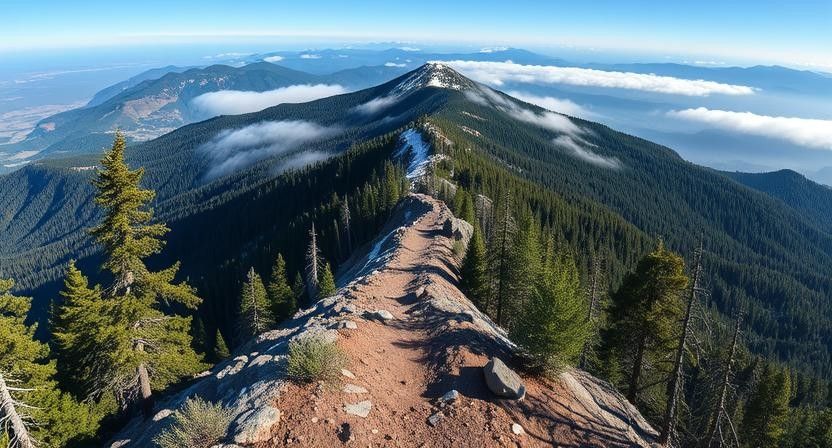
Introductory Paragraph
Humphreys Peak Trail represents the ultimate challenge for those seeking to conquer the highest point in Arizona. Its breathtaking 360-degree views provide a once-in-a-lifetime experience for avid hikers, solidifying it as one of the top hiking trails in Arizona. This trail draws those who are passionate about reaching new heights in both literal and figurative senses.
Trail Distance, Difficulty & Permits
The trail covers roughly 10 miles round-trip with a steep and demanding ascent. While permits are typically not required for day hikes on this trail, it is important to check local regulations as conditions can change.
Best Time to Visit
Early fall is the best time to hike Humphreys Peak when the weather is cool and the surrounding forests display brilliant fall colors—ideal for capturing the most scenic hikes in Arizona.
Personal Tips & Safety Precautions
Prepare for the higher elevation by acclimating properly, wearing layered clothing, and carrying sufficient water and snacks. Stay alert to rapidly changing weather conditions and plan your hike carefully for a safe, rewarding experience.
7. Camelback Mountain – Phoenix, Arizona

Introductory Paragraph
Camelback Mountain is an iconic urban hike in Phoenix that blends a physical challenge with spectacular views of the city and desert below. It is celebrated as one of the best hikes in Arizona for both locals and visitors, providing an exhilarating workout along with an unforgettable panorama of Phoenix.
Trail Distance, Difficulty & Permits
Camelback Mountain offers a round-trip distance ranging between 2.5 and 4 miles, featuring steep climbs that demand good physical fitness. While no permits are necessary, parking can be scarce, so it’s important to plan your visit ahead of time.
Best Time to Visit
Hiking early in the morning during the cooler months is recommended to avoid the intense desert heat and large crowds, ensuring a safer and more enjoyable experience on one of the top hiking spots in Arizona.
Personal Tips & Safety Precautions
Wear proper hiking shoes and consider using hiking poles to help with the steep ascents. Keep plenty of water handy and check local forums for up-to-date trail reviews and conditions. These tips can greatly enhance your urban hiking adventure.
8. The Wave – Arizona’s Iconic Desert Hike

Introductory Paragraph
Although technically located in the Vermilion Cliffs area, The Wave represents one of the most iconic desert hikes in Arizona. Revered for its surreal, undulating rock formations and vibrant color contrasts, it is often listed among the best hikes in Arizona. This trail is a bucket-list experience for adventure seekers and geology enthusiasts alike.
Trail Distance, Difficulty & Permits
The Wave is a strenuous, permit-based hike known for its challenging off-trail navigation and breathtaking geological features. Due to high demand, permits are awarded through a lottery system, so planning well in advance is necessary.
Best Time to Visit
The optimal time to hike The Wave is during early spring or late fall when the desert temperatures are more moderate. These times not only improve safety but also enhance the visual experience of the trail’s striking rock formations.
Personal Tips & Safety Precautions
Advance planning is crucial for this permit-based hike. Ensure you carry sufficient water, bring a GPS device due to limited cell service, and consider joining a guided tour for a safer experience. These practical tips are essential for tackling one of the most spectacular hiking destinations in Arizona.
9. Boynton Canyon – Sedona, Arizona

Introductory Paragraph
Boynton Canyon in Sedona is celebrated for its rich red rock formations, spiritual energy, and spectacular vistas. This trail is a balanced offering for those seeking a moderate hike that is both physically engaging and visually stunning, making it one of the best hikes in Sedona Arizona.
Trail Distance, Difficulty & Permits
The Boynton Canyon trail is approximately 6 miles round-trip with moderate difficulty. It does not require permits and features a diverse path that alternates between rocky surfaces and gentle slopes, accommodating a wide range of hiking abilities.
Best Time to Visit
Hikers will find that spring and fall are the ideal seasons to visit Boynton Canyon. The moderate temperatures and the canyon’s vibrant colors during these times elevate the experience and allow for comfortable hiking.
Personal Tips & Safety Precautions
Bring ample water, layer your clothing to adjust to changing conditions, and carry a camera to capture the canyon’s unique beauty. Taking frequent breaks on the steeper sections can help preserve your energy and enhance safety, ensuring that your hike is both enjoyable and memorable.
10. Mount Lemmon – Tucson, Arizona
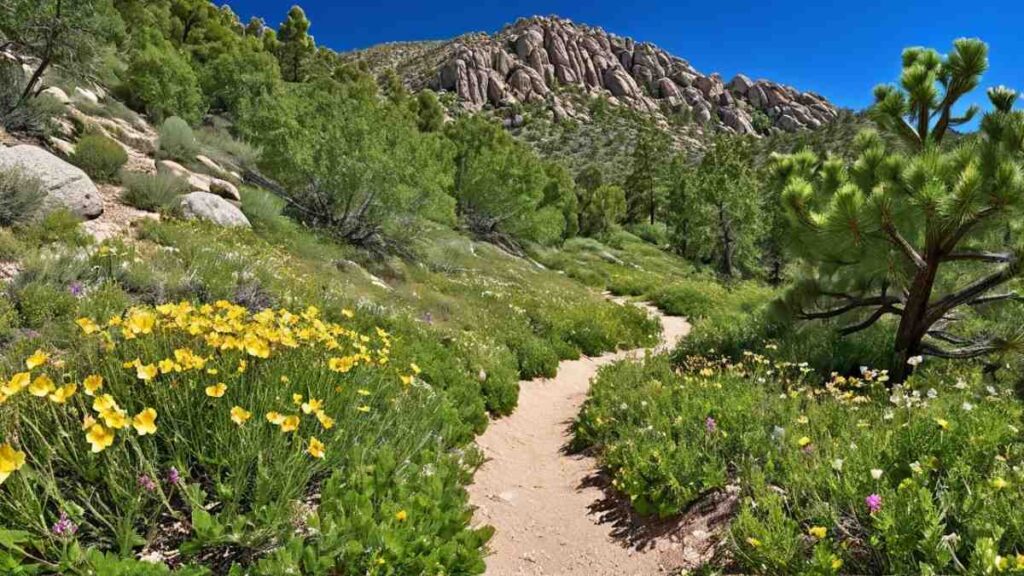
Introductory Paragraph
Mount Lemmon, near Tucson, offers a refreshing contrast to the surrounding desert with its alpine forests and cooler mountain air. Recognized as one of the best hikes in Arizona for its dramatic elevation change, this trail provides breathtaking vistas of both the desert below and the mountain ecosystems above.
Trail Distance, Difficulty & Permits
Mount Lemmon features a variety of trails ranging from 5 to 10 miles in length, with difficulty levels that span from moderate to strenuous. No permits are typically required for day hikes, although parking and entrance fees may apply during busy seasons.
Best Time to Visit
It is best to hike Mount Lemmon during the cooler months—from late fall through early spring—when the higher elevation offers relief from Tucson’s desert heat. This also provides a more comfortable and safer hiking environment.
Personal Tips & Safety Precautions
Hikers should be prepared for rapid weather changes at higher elevations by bringing a light jacket and plenty of water. Using a detailed trail map and, if possible, joining a guided hike can enrich the experience, especially for those new to the area.
Comparison Table of Best Hikes in Arizona
| Trail Name | Distance | Elevation Gain | Difficulty | Best Time to Hike | Quick Highlights |
|---|---|---|---|---|---|
| Piestewa Peak – Phoenix | 2.4 miles | 1,208 ft | ⭐⭐⭐☆☆ (Moderate) | Spring & Fall mornings | Urban desert hike with panoramic city‑and‑desert skyline views at sunrise. |
| Shaw Butte Trail – Scottsdale | 4.1 miles | 935 ft | ⭐⭐⭐☆☆ (Moderate) | Spring & Fall | Sonoran Desert trek past unique rock formations and vibrant desert blooms. |
| Cathedral Rock Trail – Sedona | 1.2 miles | 600 ft | ⭐⭐⭐⭐☆ (Moderate–Hard) | Early morning & late afternoon | Iconic red‑rock spire ascent with breathtaking Sedona vistas—perfect for photographers. |
| Devil’s Bridge Trail – Sedona | 4.2 miles | 400 ft | ⭐⭐⭐☆☆ (Moderate) | Spring & Fall | Famous sandstone arch, scenic red rock landscape, and easy access from Sedona’s backroads. |
| South Kaibab Trail – Grand Canyon | 12.0 miles | 4,780 ft | ⭐⭐⭐⭐☆ (Hard) | Early spring & late fall | World‑renowned rim‑to‑river views, dramatic canyon walls, and unforgettable Grand Canyon vistas. |
| Humphreys Peak Trail – Flagstaff | 10.2 miles | 4,400 ft | ⭐⭐⭐⭐☆ (Hard) | Early fall | Arizona’s highest summit with alpine forests, panoramic 360° views, and cool mountain air. |
| Camelback Mountain – Phoenix | 2.5 miles | 1,280 ft | ⭐⭐⭐⭐☆ (Hard) | Winter & early mornings | Urban challenge climb with rugged granite slopes and skyline‑to‑desert panoramas. |
| The Wave – Vermilion Cliffs | 6.0 miles | 400 ft | ⭐⭐⭐⭐☆ (Moderate–Hard) | Early spring & late fall | Surreal, undulating sandstone waves; permit‑only lottery hike into otherworldly rock formations. |
| Boynton Canyon – Sedona | 6.1 miles | 400 ft | ⭐⭐⭐☆☆ (Moderate) | Spring & Fall | Spiritual red‑rock canyon loop with sweeping vistas, energy vortex sites, and gentle terrain. |
| Mount Lemmon – Tucson | 5.0 miles | 1,550 ft | ⭐⭐⭐☆☆ (Moderate) | Late fall through spring | Alpine forest transition from desert, wildflower meadows, and panoramic views over the Tucson basin. |
Regional Hiking in Arizona: Explore by Area
Arizona’s expansive and varied landscape offers an incredible array of hiking experiences that cater to every taste. Whether you are looking for the vibrant red rock splendor of Sedona, the high desert adventures near Phoenix, or the rugged mountains of northern Arizona, there is something here for every outdoor enthusiast. In this section, we break down the best hiking areas across the state so you can easily plan your next adventure with confidence.
Hiking in Northern Arizona
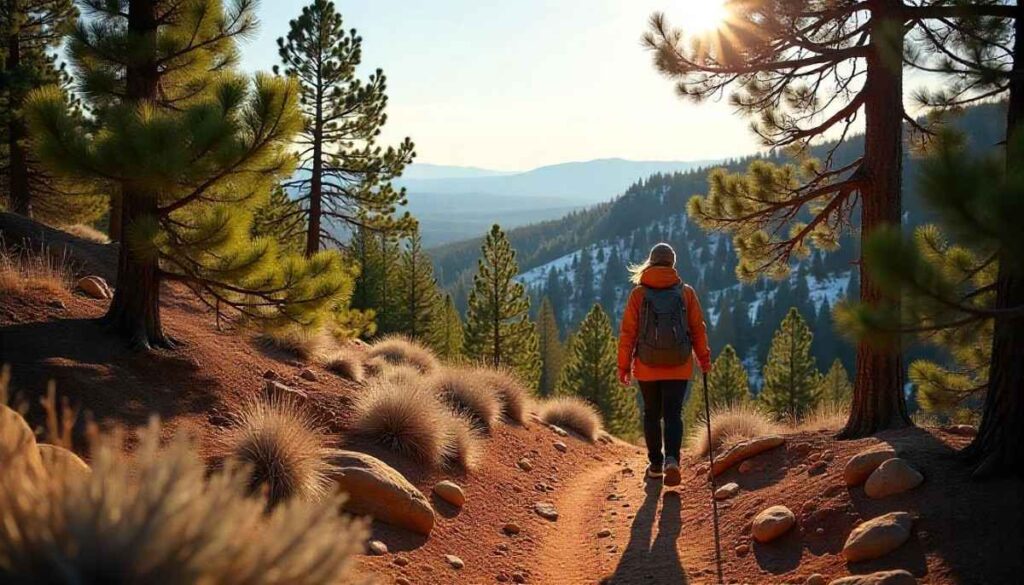
Northern Arizona is renowned for its dramatic landscapes and breathtaking views, making it a top choice for hiking in Arizona enthusiasts. Trails around Flagstaff and the Colorado Plateau offer some of the most scenic places in Arizona, where you can experience bucket list hikes amid towering pines, expansive deserts, and ancient rock formations. Notable destinations include iconic spots that are often featured on AZ hiking trails maps and frequently discussed on sites like AllTrails. Whether you are trekking through forested areas or exploring remote canyons, the natural beauty and sense of discovery here are unparalleled.
Local experts and hiking guides consistently praise northern Arizona for its unspoiled nature and the rugged charm of its trails. These hikes are perfect for adventurers seeking a combination of physical challenge and visual rewards. Engaging with the local hiking community can further enhance your experience, as many seasoned hikers share tips about hiking in northern Arizona on various online forums and through Arizona hiking tours. This area promises some of the best hiking trails in Arizona that are as challenging as they are beautiful.
Hiking in Southern Arizona
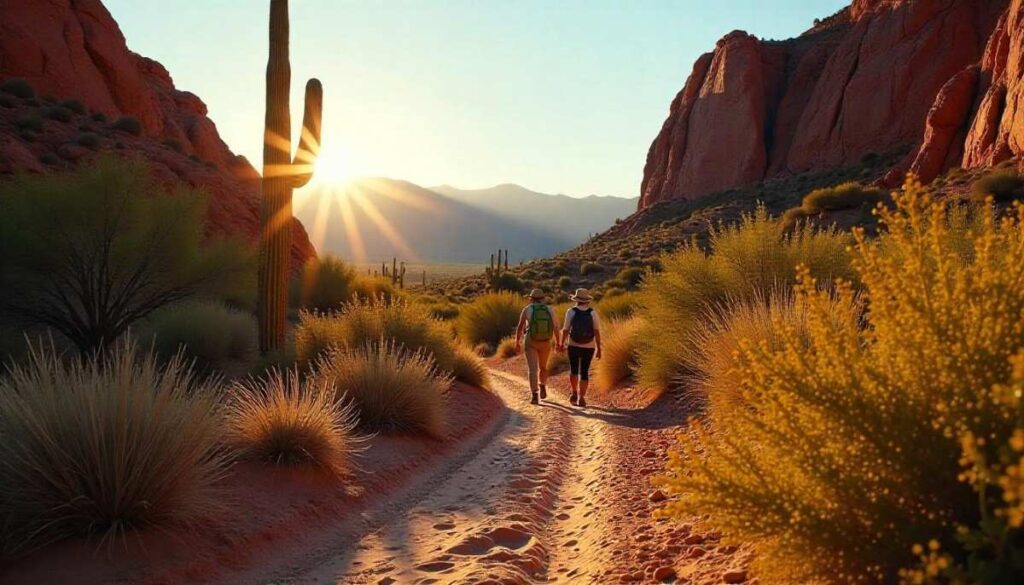
Southern Arizona presents a unique mix of arid desert landscapes and lush, unexpected oases that offer a compelling backdrop for hiking adventures. Near Tucson, you can explore hiking in Tucson Arizona on trails that lead you through the heart of the desert, where every step reveals the stark beauty of the Southwest. This region is celebrated for its expansive, sun-drenched vistas and dramatic rock formations which add an extra layer of beauty to the experience. Many of these routes rank among the best places to hike in Arizona, attracting visitors looking for both solitude and adventure.
The trails in southern Arizona are often less crowded, giving you a more intimate encounter with nature. Whether you are hiking along ancient desert paths or exploring hidden valleys, the area provides a distinctive blend of challenge and tranquility.
Urban and Suburban Trails in Arizona
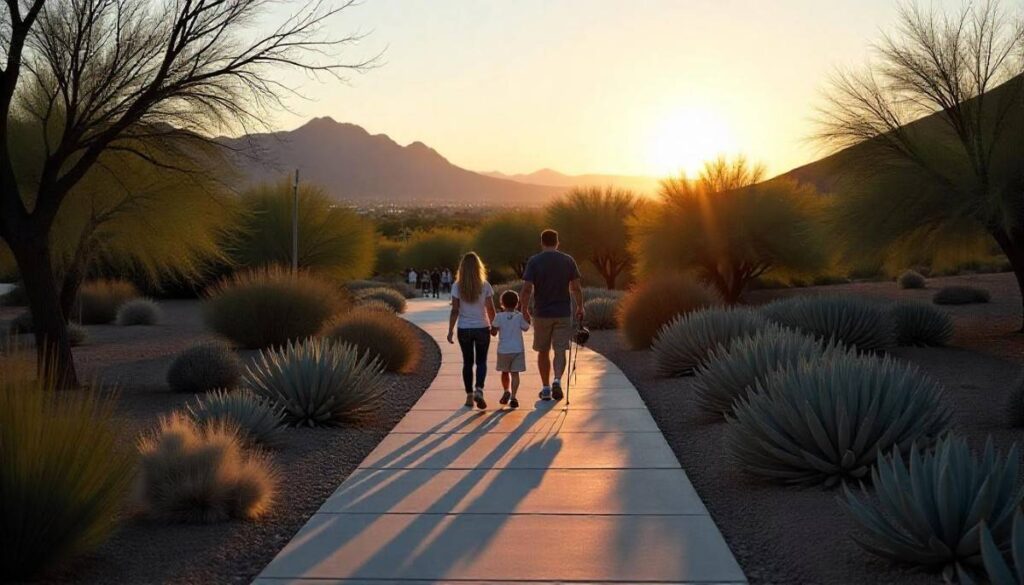
Urban and suburban hiking in Arizona, particularly in cities like Phoenix and Scottsdale, provides a refreshing escape from the hustle and bustle of city life. Hiking in Phoenix Arizona offers a mix of nature and urban landscapes, where well-maintained trails wind through city parks and along scenic ridges. These trails are designed for accessibility, allowing both seasoned hikers and families to enjoy the outdoors without venturing too far from urban conveniences. The blend of natural beauty and city energy makes these hiking spots in Arizona especially appealing to those seeking balance between adventure and comfort.
Seasonal Hiking Guide: When & Where to Go
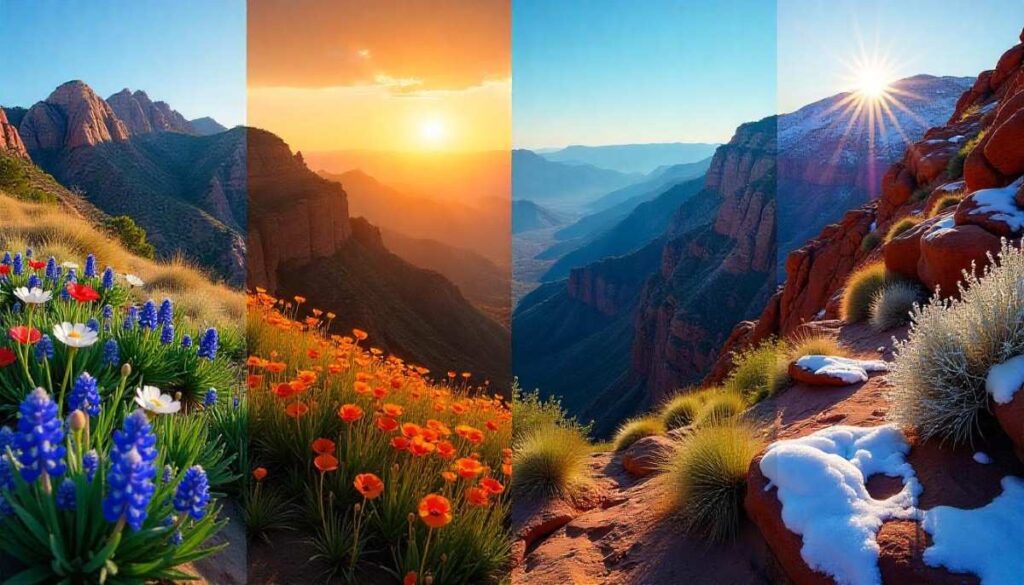
Arizona’s diverse climate transforms its hiking trails into unique experiences every season. Whether you seek the blooming beauty of spring, the refreshing cool of higher elevations in summer, the vibrant hues of fall, or the crisp solitude of winter, Arizona offers a trail for every mood and moment. This guide provides essential insights into which trails to choose, practical tips for seasonal conditions, and expert advice to help you safely enjoy the best hikes in Arizona.
Spring Hikes in Arizona
Spring in Arizona awakens the landscape with vibrant wildflowers and mild, comfortable weather, making it an ideal time for hiking in Arizona. Trails burst into life with desert flora such as bluebonnets and Indian paintbrushes, offering some of the best spring hikes in Arizona. The clear, sunny skies not only enhance the natural beauty but also allow for long, enjoyable hikes with cooler temperatures—a perfect setting for both casual hikers and experienced adventurers.
This season is celebrated for its scenic hikes in Arizona where every step reveals blooming nature. As the desert flora flourishes, trails around Sedona and Prescott transform into colorful corridors ideal for photography and peaceful exploration. Local experts recommend starting early in the day to make the most of the mild temperatures.
Summer Hikes in Arizona
The intense summer heat in Arizona requires strategic planning, making early-morning or high-altitude routes the best choice for hiking in Arizona during this season. In the summer, the best hiking trails in Arizona become accessible when you opt for routes that avoid peak sun hours. Trails in areas such as Flagstaff or higher elevations in the Superstition Mountains are excellent choices, as they offer natural shade and cooler temperatures.
For summer hikes, prioritize hydration and sun protection. Experts advise carrying water in ample quantities and wearing sun hats, sunglasses, and sunscreen to combat the harsh desert sun. Additionally, selecting trails with abundant tree cover or those located in higher altitudes can help you escape the relentless heat, ensuring you have a safe and enjoyable hiking experience.
Fall Hikes in Arizona
Fall is arguably one of the most popular times for hiking in Arizona due to the cool, pleasant temperatures and the breathtaking display of vibrant autumn colors. The best fall hikes in Arizona are characterized by soft autumn light, which casts a warm glow over red rock formations and desert vistas, making these trails perfect for photography and leisurely hikes.
Trails in the northern parts of the state, like those around Flagstaff, and many beautiful hiking trails in Arizona near Sedona offer a spectacular backdrop of changing leaves and crisp air. The moderate weather during this time enhances the overall hiking experience, allowing for extended day hikes without the discomfort of extreme heat. Local hiking groups and tour guides of Arizona suggest fall as an excellent season to explore hidden gems and renowned trails alike.
Winter Hikes in Arizona
Winter in Arizona reveals a quieter, more introspective side of the state, with trails that are often low-traffic and imbued with tranquility. For those looking for the best winter hikes in Arizona, options include exploring state parks and rugged desert paths that remain safely accessible during the colder months.
The crisp winter air, often accompanied by clearer views and fewer crowds, makes for a rewarding hiking experience. Regions such as the high country near Flagstaff and certain trails within Arizona state parks showcase the beauty of a winter landscape where the muted light and cooler temperatures create an inviting environment for hiking. For detailed hiking in winter guide click here.
Arizona Hiking Safety & Essentials
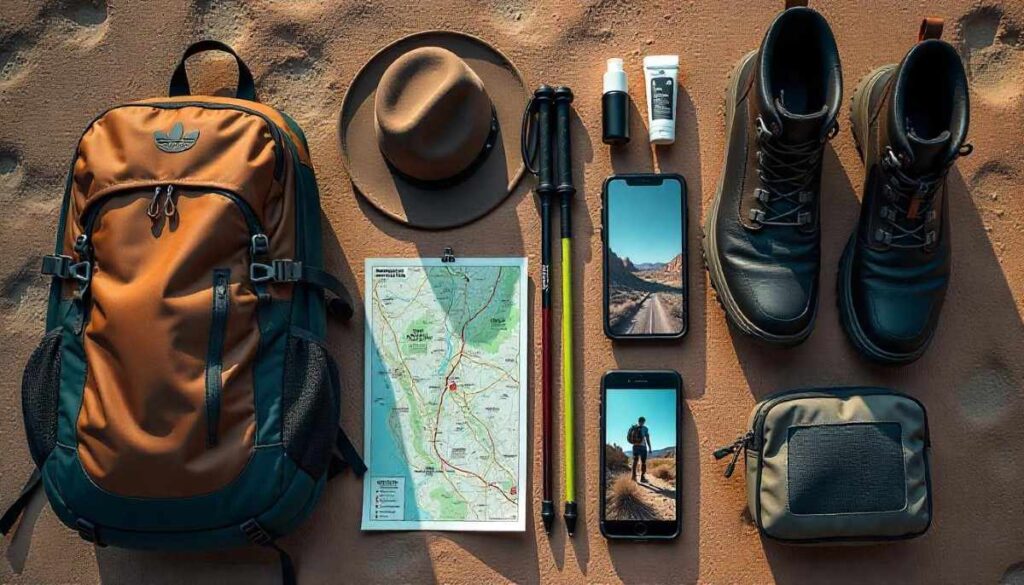
When planning your adventures in Arizona, safety should be your top priority. With its diverse landscapes—from arid deserts and rugged canyons to cool high-country forests—hiking in Arizona demands proper planning and preparation. This comprehensive guide provides expert tips on essential gear, weather and wildlife precautions, and crucial rules for hiking in Arizona’s state parks and national forests, ensuring a safe and memorable experience.
Gear Checklist
Preparing for your trek in Arizona starts with assembling the right gear tailored to the state’s variable climates. For summer hikes, pack lightweight and breathable clothing to stay cool and comfortable, while winter excursions call for layered outfits to adapt to colder temperatures at higher altitudes.
Investing in high-quality hiking boots is essential for tackling rugged, rocky trails—key for any serious hiking in Arizona experience. Additionally, using trekking poles can help provide extra support during steep ascents, and a good sun hat coupled with ample hydration packs ensures you remain protected from the harsh desert sun.
Weather and Wildlife Tips
Arizona’s climate can vary dramatically, with scorching desert heat in the lowlands and surprisingly chilly conditions in the mountains. Always check the weather forecast before heading out—resources like the National Weather Service offer up-to-date information that is critical for planning a safe hiking in Arizona adventure.
When exploring remote trails, it is also important to be prepared for wildlife encounters. While Arizona is home to a diverse range of creatures, maintaining a safe distance and securing food items properly can prevent unwanted interactions. Expert hikers advise that carrying sufficient water, sun protection, and a basic first aid kit is essential, especially when venturing into less-traveled areas. Engaging with local hiking tours or forums can provide additional insights on current trail conditions and local fauna behavior.
Conclusion
Whether you’re drawn to the urban challenge of Piestewa Peak, the stunning red‑rock spires of Cathedral Rock Trail, or the otherworldly waves of The Wave, Arizona offers an unmatched variety of best hikes in Arizona for every outdoor enthusiast. From hiking in Phoenix Arizona and hiking in Sedona Arizona to high‑elevation climbs like Humphreys Peak Trail, these Arizona hiking trails showcase the state’s diverse landscapes—deserts, mountains, canyons, and alpine forests.
By following expert advice on gear, weather, and safety, you can confidently tackle the best hiking trails in Arizona year‑round. Remember to check resources like the National Park Service for up‑to‑date trail conditions and permits, and explore our other guides on places to hike in Arizona for insider tips on hidden gems. Lace up your boots and start planning your next adventure—your perfect slice of hiking in Arizona awaits!
Ethan Marlowe is an experienced hiker and outdoor gear specialist based in Colorado. With over 7 years of hands-on experience trekking through the Rockies, Pacific Northwest, and East Coast trails, he delivers practical advice, expert gear reviews, and survival insights. His goal is to help hikers of all levels make smarter decisions on and off the trail.

